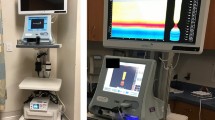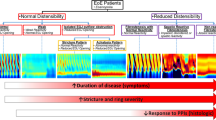Abstract
Purpose of Review
Functional lumen impedance (FLIP) technology has become commercially available to assess structural and motor abnormalities of the esophagus. Increasing numbers of papers have described novel findings with this technology. This review examines the validity of the FLIP technique, how it compares with existing diagnostic modalities, and evidence to date on diagnostic accuracy.
Recent Findings
FLIP studies require deep sedation at the time of endoscopy to complete. They assess a simulated state of esophageal obstruction in only a distal part of the esophagus rather than deglutitive motor function of the entire esophagus. The available normative dataset is small and not matched to the older age of patients typically being evaluated. The test-retest agreement in health and disease is unknown, as is the operator dependence on performing and interpreting findings. Studies to date have largely excluded patients with structural disorders, which FLIP cannot reliably distinguish from motor disorders.
Summary
FLIP is an expensive technology that has been made clinically available without its true utility being established. For FLIP to be deemed a device ready for widespread clinical use, additional studies on validity, diagnostic accuracy, and outcomes need to be performed. Prospective clinical studies need to include all patients and assess the incremental cost-effectiveness of FLIP over more innovative use of existing technology, such as high-resolution manometry with provocative challenges.

Similar content being viewed by others
References
Liu J, Parashar VK, Mittal RK. Asymmetry of lower esophageal sphincter pressure: is it related to the muscle thickness or its shape? Am J Physiol Gastrointest Liver Physiol. 1997;272:G1509–17.
McMahon BP, Frøkjær JB, Kunwald P, Liao D, Funch-Jensen P, Drewes AM, et al. The functional lumen imaging probe (FLIP) for evaluation of the esophagogastric junction. Am J Physiol Gastrointest Liver Physiol. 2007;292:G377–84. https://doi.org/10.1152/ajpgi.00311.2006.
McMahon BP, Frøkjær JB, Liao D, Kunwald P, Drewes AM, Gregersen H. A new technique for evaluating sphincter function in visceral organs: application of the functional lumen imaging probe (FLIP) for the evaluation of the oesophago–gastric junction. Physiol Meas. 2005;26:823–36.
Liao D, Lottrup C, Fynne L, McMahon BP, Krogh K, Drewes AM, et al. Axial movements and length changes of the human lower esophageal sphincter during respiration and distension-induced secondary peristalsis using functional luminal imaging probe. J Neurogastroenterol Motil. 2018;24:255–67.
Nathanson LK, Brunott N, Cavallucci D. Adult esophagogastric junction distensibility during general anesthesia assessed with an endoscopic functional luminal imaging probe (EndoFLIP®). Surg Endosc. 2012;26:1051–5. https://doi.org/10.1007/s00464-011-1996-3.
Rohof WO, Hirsch DP, Kessing BF, Boeckxstaens GE. Efficacy of treatment for patients with achalasia depends on the distensibility of the esophagogastric junction. Gastroenterology. 2012;143:328–35. https://doi.org/10.1053/j.gastro.2012.04.048.
Pandolfino JE, de Ruigh A, Nicodème F, Xiao Y, Boris L, Kahrilas PJ. Distensibility of the esophagogastric junction assessed with the functional lumen imaging probe (FLIP™) in achalasia patients. Neurogastroenterol Motil. 2013;25:496–501. https://doi.org/10.1111/nmo.12097.
Familiari P, Gigante G, Marchese M, Boskoski I, Bove V, Tringali A, et al. EndoFLIP system for the intraoperative evaluation of peroral endoscopic myotomy. United European Gastroenterol J. 2014;2:77–83. https://doi.org/10.1177/2050640614521193.
Manthey MW, Massey BT, Arndorfer RC, Hogan WJ. Determinants of lower esophageal sphincter relaxation induced by esophageal balloon distension in humans. Am J Physiol Gastrointest Liver Physiol. 1996;270:G1022–7. https://doi.org/10.1152/ajpgi.1996.270.6.G1022.
Shaker R, Bardan E, Gu C, Massey BT, Sanders T, Kern MK, et al. Effect of lower esophageal sphincter tone and crural diaphragm contraction on distensibility of the gastroesophageal junction in humans. Am J Physiol Gastrointest Liver Physiol. 2004;287:G815–21. https://doi.org/10.1152/ajpgi.00120.2004.
Paterson WG. Esophageal and lower esophageal sphincter response to balloon distention in patients with achalasia. Dig Dis Sci. 1997;42:106–12. https://doi.org/10.1023/A:1018893206926.
Babaei A, Shad S, Szabo A, Massey BT. Pharmacologic interrogation of patients with esophagogastric junction outflow obstruction using amyl nitrite. Neurogastroenterol Motil. 2019;31:e13668. https://doi.org/10.1111/nmo.13668.
Mittal RK, Shaffer HA, Parollisi S, et al. Influence of breathing pattern on the esophagogastric junction pressure and esophageal transit. Am J Phys. 1995;269:G577–83.
Nicodème F, Hirano I, Chen J, et al. Esophageal distensibility as a measure of disease severity in patients with eosinophilic esophagitis. Clin Gastroenterol Hepatol. 2013;11:1101–1107.e1. https://doi.org/10.1016/j.cgh.2013.03.020.
Kwiatek MA, Hirano I, Kahrilas PJ, Rothe J, Luger D, Pandolfino JE. Mechanical properties of the esophagus in eosinophilic esophagitis. Gastroenterology. 2011;140:82–90. https://doi.org/10.1053/j.gastro.2010.09.037.
Carlson DA, Lin Z, Hirano I, Gonsalves N, Zalewski A, Pandolfino JE. Evaluation of esophageal distensibility in eosinophilic esophagitis: an update and comparison of functional lumen imaging probe analytic methods. Neurogastroenterol Motil. 2016;28:1844–53. https://doi.org/10.1111/nmo.12888.
Lin Z, Nicodème F, Boris L, Lin CY, Kahrilas PJ, Pandolfino JE. Regional variation in distal esophagus distensibility assessed using the functional luminal imaging probe (FLIP). Neurogastroenterol Motil. 2013;25:e765–71. https://doi.org/10.1111/nmo.12205.
Paterson WG, Hynna-Liepert TT, Selucky M. Comparison of primary and secondary esophageal peristalsis in humans: effect of atropine. Am J Phys. 1991;260:G52–7. https://doi.org/10.1152/ajpgi.1991.260.1.G52.
Schoeman MN, Holloway RH. Integrity and characteristics of secondary oesophageal peristalsis in patients with gastro-oesophageal reflux disease. Gut. 1995;36:499–504. https://doi.org/10.1136/gut.36.4.499.
Kwiatek MA, Pandolfino JE, Hirano I, Kahrilas PJ. Esophagogastric junction distensibility assessed with an endoscopic functional luminal imaging probe (EndoFLIP). Gastrointest Endosc. 2010;72:272–8. https://doi.org/10.1016/j.gie.2010.01.069.
Carlson DA, Kou W, Lin Z, et al. Normal values of esophageal distensibility and distension-induced contractility measured by functional luminal imaging probe panometry. Clin Gastroenterol Hepatol. 2019;7:674–81.e1. https://doi.org/10.1016/j.cgh.2018.07.042.
Ren J, Shaker R, Kusano M, Podvrsan B, Metwally N, Dua KS, et al. Effect of aging on the secondary esophageal peristalsis: presbyesophagus revisited. Am J Phys. 1995;268(5 Pt 1):G772–9. https://doi.org/10.1152/ajpgi.1995.268.5.G772.
Penagini R, Picone A, Bianchi PA. Effect of morphine and naloxone on motor response of the human esophagus to swallowing and distension. Am J Phys. 1996;271:G675–80. https://doi.org/10.1152/ajpgi.1996.271.4.G675.
Pitt KA, Mayhew PD, Barter L, Pollard R, Kass PH, Marks SL, et al. Consistency and effect of body position change on measurement of upper and lower esophageal sphincter geometry using impedance planimetry in a canine model. Dis Esophagus. 2017;30:1–7. https://doi.org/10.1093/dote/dow031.
Bianca A, Schindler V, Schnurre L, Murray F, Runggaldier D, Gyawali CP, et al. Endoscope presence during endoluminal functional lumen imaging probe (FLIP) influences FLIP metrics in the evaluation of esophageal dysmotility. Neurogastroenterol Motil. 2020;32:e13823. https://doi.org/10.1111/nmo.13823.
Madanick RD, Shaheen NJ, Dellon ES. A novel balloon pull-through technique for esophageal dilation in eosinophilic esophagitis (with video). Gastrointest Endosc. 2011;73:138–42. https://doi.org/10.1016/j.gie.2010.09.034.
Massey BT. EndoFLIP assessment of achalasia therapy: interpreting the distensibility data is a bit of a stretch. Gastroenterology. 2013;144:e17–8. https://doi.org/10.1053/j.gastro.2012.12.039.
Ponds FA, Oors JM, Smout AJPM, Bredenoord AJ. Rapid drinking challenge during high-resolution manometry is complementary to timed barium esophagogram for diagnosis and follow-up of achalasia. Neurogastroenterol Motil. 2018;30:e13404. https://doi.org/10.1111/nmo.13404.
Babaei A, Shad S, Massey BT. Motility patterns following esophageal pharmacologic provocation with amyl nitrite or cholecystokinin during high-resolution manometry distinguish idiopathic vs opioid-induced type 3 achalasia. Clin Gastroenterol Hepatol. 2020;18:813–821.e1. https://doi.org/10.1016/j.cgh.2019.08.014.
Cameron AJ, Malcolm A, Prather CM, Phillips SF. Videoendoscopic diagnosis of esophageal motility disorders. Gastrointest Endosc. 1999;49:62–9. https://doi.org/10.1016/s0016-5107(99)70447-5.
Massey BT, Simuncak C, LeCapitaine-Dana NJ, Pudur S. Transient lower esophageal sphincter relaxations do not result from passive opening of the cardia by gastric distention. Gastroenterology. 2006;130:89–95. https://doi.org/10.1053/j.gastro.2005.11.003.
Holloway RH, Wyman JB, Dent J. Failure of transient lower oesophageal sphincter relaxation in response to gastric distension in patients with achalasia: evidence for neural mediation of transient lower oesophageal sphincter relaxations. Gut. 1989;30:762–7. https://doi.org/10.1136/gut.30.6.762.
Schoeman MN, Holloway RH. Secondary oesophageal peristalsis in patients with non-obstructive dysphagia. Gut. 1994;35:1523–8. https://doi.org/10.1136/gut.35.11.1523.
Carlson DA, Kahrilas PJ, Lin Z, Hirano I, Gonsalves N, Listernick Z, et al. Evaluation of esophageal motility utilizing the functional lumen imaging probe. Am J Gastroenterol. 2016;111:1726–35. https://doi.org/10.1038/ajg.2016.454.
Carlson DA, Gyawali CP, Kahrilas PJ, et al. Esophageal motility classification can be established at the time of endoscopy: a study evaluating real-time functional luminal imaging probe panometry. Gastrointest Endosc. 2019;90:915–23.e1. https://doi.org/10.1016/j.gie.2019.06.039.
Baumann AJ, Donnan EN, Triggs JR, et al. Normal functional luminal imaging probe panometry findings associate with lack of major esophageal motility disorder on high-resolution manometry [published online ahead of print, 2020 Mar 20]. Clin Gastroenterol Hepatol. 2020:S1542-3565(20)30352-9. https://doi.org/10.1016/j.cgh.2020.03.040.
Carlson DA, Kahrilas PJ, Ritter K, Lin Z, Pandolfino JE. Mechanisms of repetitive retrograde contractions in response to sustained esophageal distension: a study evaluating patients with postfundoplication dysphagia. Am J Physiol Gastrointest Liver Physiol. 2018;314:G334–40. https://doi.org/10.1152/ajpgi.00368.2017.
Acknowledgments
The author gratefully acknowledges Arash Babaei and Mark Kern for their review and constructive suggestions in the preparation of this manuscript.
Author information
Authors and Affiliations
Corresponding author
Ethics declarations
Conflict of Interest
The author declares that he has no conflicts of interest to report.
Human and Animal Rights
This article does not contain any studies with human or animal subjects performed by any of the authors.
Additional information
Publisher’s Note
Springer Nature remains neutral with regard to jurisdictional claims in published maps and institutional affiliations.
This article is part of the Topical Collection on Esophagus
Rights and permissions
About this article
Cite this article
Massey, B.T. Flip Technology for Assessing Esophageal Structural and Motor Disorders: a Skeptic’s View. Curr Gastroenterol Rep 22, 44 (2020). https://doi.org/10.1007/s11894-020-00782-2
Published:
DOI: https://doi.org/10.1007/s11894-020-00782-2




